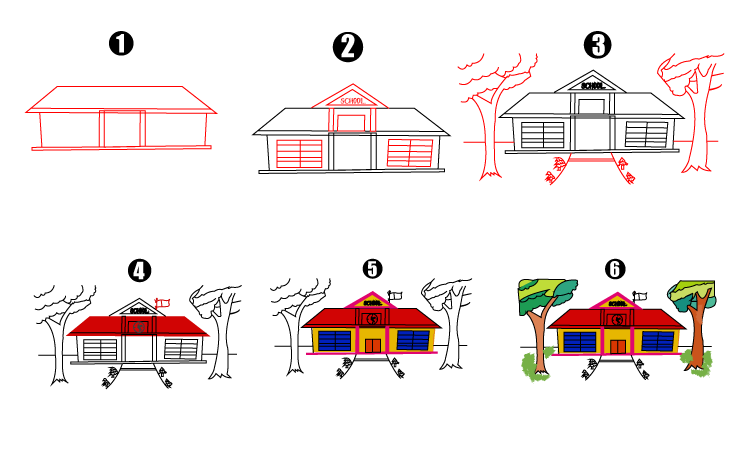Introduction
Drawing a school can be a fun and educational activity for both children and adults. Whether you’re looking to create a simple sketch or a detailed illustration, knowing how to break down the process can make it more manageable and enjoyable. This step-by-step guide will walk you through the basics of drawing a school, from the initial sketch to the final touches.
Step 1: Gather Your Materials
Before you start drawing, gather the materials you’ll need:
- Pencil and eraser
- Paper
- Ruler
- Colored pencils, markers, or crayons (optional for adding color)
Step 2: Sketch the Basic Shapes
Start by sketching the basic shapes that will form the structure of the school.
Draw the Main Building:
- Begin with a large rectangle in the center of your paper. This will be the main part of the school building.
- Add a smaller rectangle on top of the main rectangle to represent the roof. You can make this roof flat or triangular, depending on your preference.
Add the Front Entrance:
- Draw a smaller rectangle at the bottom center of the large rectangle to create the entrance door.
- You can add a few lines above the door to indicate a canopy or overhang.
Add Windows:
- Draw several small squares or rectangles on the main building to represent windows. Typically, schools have multiple windows, so arrange them in a grid-like pattern.
Draw the Roof Details:
- Add details to the roof, such as shingles or tiles, if you like. For a simple roof, just draw a few horizontal lines to indicate texture.
Step 3: Add Architectural Details
Now that you have the basic structure, it’s time to add details to make your drawing more realistic.
Refine the Windows and Door:
- Add window panes by drawing intersecting lines inside each window. For the door, you might draw a doorknob and some panels to give it more character.
Add the School’s Sign:
- Draw a rectangle or banner above the entrance to represent the school’s nameplate. You can write “School” or add any other text you like.
Include Additional Features:
- Draw details such as bricks or siding on the walls of the building. You can add lines or patterns to give texture and depth.
Add a Flagpole:
- If you want to include a flagpole, draw a thin vertical line extending from the roof, and add a small rectangle at the top for the flag. You can then draw the flag itself waving in the breeze.
Step 4: Draw the Surrounding Elements
To complete your drawing, add elements around the school to give it context.
Draw the Ground:
- Add a horizontal line at the base of the school to represent the ground. You can also sketch a sidewalk leading up to the entrance.
Include Trees and Plants:
- Draw a few trees or shrubs around the school to add some greenery. Simple tree shapes, such as circles or ovals for the foliage, can be used.
Add Details to the Yard:
- You might include a playground, benches, or a schoolyard with a few simple lines or shapes.
Step 5: Outline and Color
Once you’re satisfied with your drawing, go over the lines with a darker pencil or pen to make them stand out.
Outline Your Drawing:
- Carefully trace over your pencil lines with a fine-tip pen or marker. Erase any remaining pencil marks after the ink has dried.
Add Color:
- Use colored pencils, markers, or crayons to add color to your drawing. Choose colors for the walls, roof, windows, and any additional elements. Be creative with the colors to make your school look vibrant and inviting.
Step 6: Add Final Touches
To complete your drawing, add any final details that will enhance its appearance.
Add Shadows and Highlights:
- Lightly shade areas that would naturally be darker to add depth. For example, the side of the building facing away from the light might be shaded slightly.
Refine the Details:
- Make any final adjustments to the lines or colors to ensure everything looks polished and complete.
Conclusion:
Drawing a school can be a rewarding and enjoyable process, whether you're creating a simple sketch or a detailed illustration. By following these steps, you can capture the essence of a school and add your personal touch. So grab your materials, let your creativity flow, and enjoy the process of bringing your school drawing to life!
Always Visit our blog Easy Kids Learning Corner



